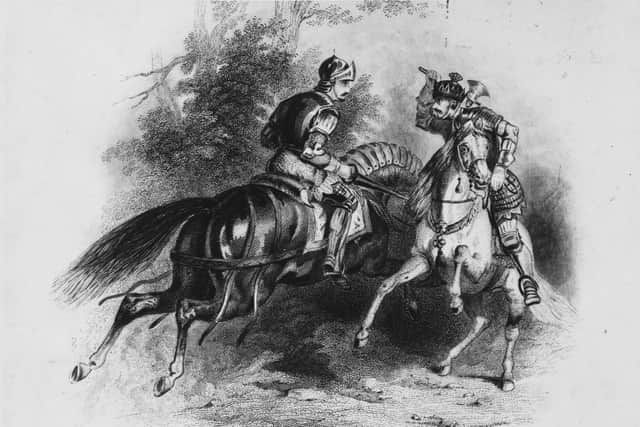Robert the Bruce's victory at Bannockburn is a timeless reminder to never give up hope, no matter the odds – Susan Morrison
In June 1314, an English army was making its way north to aid the beleaguered force at Stirling Castle. It was commanded by Edward II, son of the notorious Edward I, nicknamed ‘Longshanks’. Also known as ‘Malleus Scotorum’. Hammer of the Scots. It was carved onto his tomb above his head. At least his body was actually in there. He’d left instructions that the flesh should be boiled away so his bones could be carried into battle for one more pop at the Scots.
Edward II declined to have his dead dad in front of him, but he had a massive army behind him. Some historians estimate about 2,000 cavalry and 16,000 foot soldiers. This was an army designed to shock and awe.
Advertisement
Hide AdAdvertisement
Hide AdThese boys had to put a wriggle on. They had a deadline to reach the Castle. A deal was struck between the besieging Scots, under the command of Robert Bruce’s brother Edward, and the English commander Sir Phillip Mowbray. If Edward of England didn’t turn up with an army to relieve the castle, then the garrison would surrender to the Bruces. Midsummer was pencilled into the diary and both sides waited.
This apparently polite deal-making was totally acceptable. It was one of the many rules and regulations around mediaeval warfare. Knights were meant to be ‘chivalric’ and play nice, especially around women, children and old people. Oh, sometimes they'd get carried away and do a bit of looting, pillaging and running amok, but boys will be boys.
Kings liked their wars ‘just’. Then as now, public opinion counted. Invasions had to be justified. Legal arguments were put forward. The English kings were forever hauling out lawyers to prove their claims to the throne of France. Good PR meant getting God on your side. This usually meant dispatching emissaries to get the Pope’s thumbs up and possibly a banner.
There were rules of engagement, even in battle. It was considered rude to surprise people. You have to let the other side get armoured up. It was quite practical. Accepting prisoners on the battlefield was lucrative. You got to ransom off your wealthy knight and that shiny armour could be worth a bob or two. Win-win all round, really.
On the morning of June 23, the time for negotiation was over. Edward II had, indeed, turned up, and no one was talking about surrender now, least of all the English king. Why should he? Everything seemed in his favour. Huge army. Pope on his side. Everyone knew the Scots had been stroppy. Looked like it had all the makings of a nice big victory to show people he was as good as his tall, skinny dad.


For Robert Bruce, it didn’t look good. No papal blessing for him. The very opposite. He’d been ex-communicated for the little matter of committing murder in a kirk. He only had about 6,000 troops facing the English, but numbers aren’t everything. Bruce was smart and knew how to pick his ground for a fight. He’d already dug pits to play merry hell with the mounted English knights. The men were well drilled. Discipline was good.
Battle would shortly be joined. It was time for Bruce to see to his division of troops and probably to thunder out one of those pre-battle speeches Hollywood screenwriters adore. Bruce saddled up a nimble little horse. The poet Barbour in his epic, The Brus, describes it as “ane gay palfray Litill and joly”.
According to historian Dr Callum Watson, at the Battle of Bannockburn Centre, a palfray was a neat, lightweight mount with a long and gentle gait. Great for travelling, but not for battle. Bruce was lightly armoured, carrying a battleaxe, but no shield. He was in a sort of pre-battle armour of leather, and of course, no well-dressed monarch went out without popping on a crown.
Advertisement
Hide AdAdvertisement
Hide AdSir Henry de Bohun was a young English knight, armed to the teeth, and astride the sort of massive warhorse you needed for serious battle. He probably hoped that this day would give him a shot at glory and everlasting fame. It was going to, but not quite as he had intended.
There, right in front of him, was the rebellious, excommunicated leader of the Scots, hardly armed, riding what's basically a wee pony and virtually on his own. It’s de Bohun’s big chance at glory, but it’s not entirely chivalrous. He spurred his great war horse and readied his lance to skewer the king.
What happens next is mildly disputed, but Barbour has King Robert wheeling his “joly palfray” round, calmly waiting until the young knight is virtually on top of him, then rising in his stirrups, raising his battleaxe with one hand to bring it down on de Bohun’s helmet. With one shattering blow, he split the young knight's skull in half, splattering his blood and brains all over that shiny armour.
When de Bohun’s body hits the deck, the Scottish army goes wild, according to Barbour, and why not? Their king had bested a heavily armoured knight with just a little pony and an axe, but Bruce gets a mild ticking off from his commanders for turning to fight, an indication that they felt that the attack was mildly unchivalrous.
Bruce only complains that he’s broken the handle of his best axe. Some called it the first blow of the battle. We don’t know when the last blow landed, but we know how it ended.
Which just goes to show that, even if the opposition has all the justification, the armoured knights and even God on their side, if you’re smart, keep the heid, and your brains in your skull, there is always a chance you can win.
Comments
Want to join the conversation? Please or to comment on this article.
